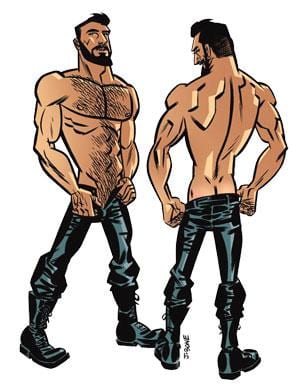Like a lot of artists, J Bone started creating as an escape from middle-school social life. A shy, awkward kid raised in Woodstock, Ontario, the Toronto comic artist and animator compensated for his lack of stature by pencilling alternate worlds where he could be anything he wanted.
“I tended towards isolation and I was never the popular kid,” he says. “Drawing myself as different superhero characters became my outlet. But in a weird way that eventually became my entry into the popular circles, because people would notice my drawings and got interested in me.”
Encouraged by the upward mobility his talents provided, he went on to study illustration at Sheridan College and promptly landed a job as an animator. Though the fast-paced work greatly enhanced his skills, labouring as a faceless member of a gigantic team eventually started to grate on him.
“It was a bit of an ego thing,” he says. “When you work in a group like that, you’re just one of many names flashing by at the end of a program. I wanted to see my name on the cover of something.”
Since then, he’s penned several of his own books, as well as working on numerous DC comics, like Spiderman, Super Friends and The Spirit. But for his contribution to the group show Powerhaus, Bone returned to his childhood experiences.
Inspired by American author Ursula K Le Guin’s assertion that the “creative adult is the child who survived,” the show commissioned 12 queer artists to share their insights on youth self-empowerment through art. Bone’s semi-autobiographical contribution is an 11- by 17-inch comic panel about a bullied kid who reimagines himself as various superheroes, only to have his talents discovered, gaining him the kind of attention he desperately craves.
“I wasn’t bullied as a kid, but I was definitely a loner,” he says. “The piece is about a kid who feels like he’s picked on but actually could be one of the popular kids based on his talent.”
Though there’s a definite innocence to the work, Bone’s other projects put sexuality front and centre. His Beefcake blog, Man’s Adventure (bonesmen.blogspot.ca), overflows with rippling abs and well-stuffed packages. Despite a Tom of Finland-esque quality to the bodies, the project stops short of balls-out erotica. In lieu of full-frontal, it hearkens back to 1950s-era physique magazines, where a bare chest and partially open fly were enough to get someone going.
“I find not seeing everything a lot sexier because you can create your own story,” he says. “Once everything’s hanging out, there’s nowhere left to go. The point where someone’s pants are about to come off is the sexiest moment for me because anything can happen.”
Though he loves his work, he’s quick to admit feeling conflicted about the way he portrays bodies — his other site, Blah, Blah, Blog! (gobukan.blogspot.com), is chock full of impossibly wasp-wasted pin-up girls. Comic art historically (and its present-day progeny, video games) tends to hypersexualize both men and women to unachievable extremes. Is he worried his work might be contributing to the gay community’s notorious culture of body fascism?
“I have moments where I feel conflicted about it, but I also can’t control how people view my work,” he says. “I’m a skinny nerd with glasses, so I don’t look like what’s typically considered desirable in the gay scene, and I don’t want to contribute to gay men feeling insecure about their bodies. I’ve had my own history of body issues, but the older I get the less I care what other people think.”


 Why you can trust Xtra
Why you can trust Xtra


